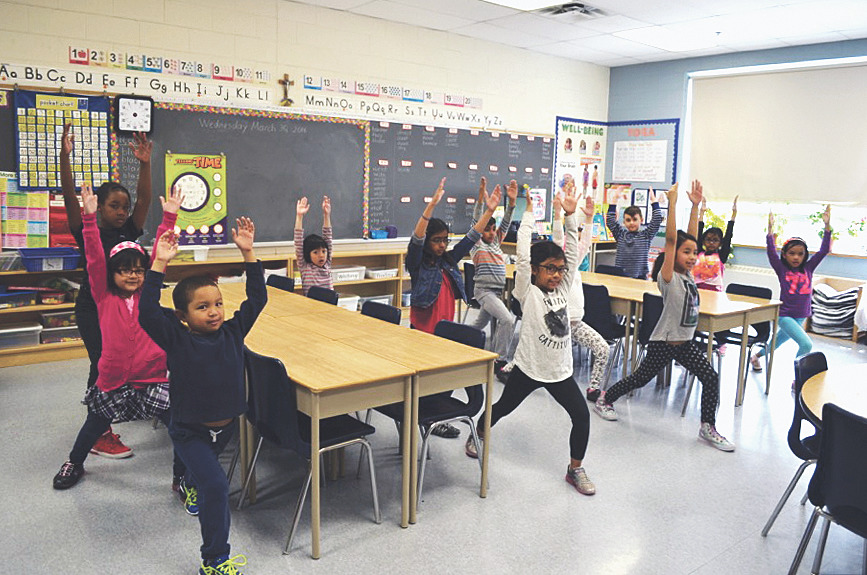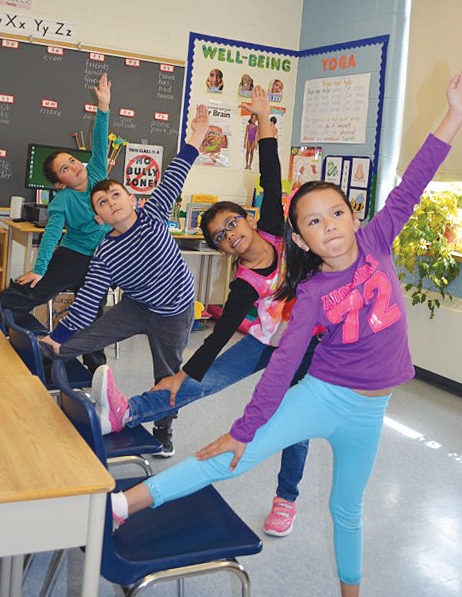As the school day begins, over 400 students and 40 teachers and support staff in 23 classrooms sit quietly and mindfully for a few minutes. When finished, they give thanks, set an intention for another productive and joyful day and go on with their daily tasks. Powerful image, isn’t it?

This has been my dream for the past 17 years as a school teacher and a yoga educator. When I learned at the beginning of the school year that our school will be focusing on mental health and well-being using mindfulness, meditation, yoga and self-regulation practices, I was very excited.
It is about time to start using yoga, meditation and mindfulness to support and deepen the learning process and to enhance the well-being of students and teachers.
The well-being committee was formed, consisting of the principal, vice principal, librarian, two special education teachers, gym teacher and three classroom teachers representing each division. From the first meeting, it became clear that we were a group of passionate professionals who were excited about the journey of learning, teaching and implementing. And so we began.
To learn anything effectively and get results we need to answer four questions: why? what? how? and if? These questions form a cycle of learning. Current brain research confirms that we travel through a four-part cycle when we take in and make meaning of new information (4MAT model created by Bernice McCarthy).
First, we had to explore the subject and ask the question “Why?”
Why Should We Pay Attention to Yoga, Mindfulness, and Meditation? Why Is It Important and Relevant?
We took some time to read, research and educate ourselves about mindfulness, meditation, yoga and self-regulation and the benefits of these practices for students and teachers.
In his article Why We Need Mindfulness at Work, Peter Jaret defines mindfulness as a “moment-to-moment awareness to your thoughts, feelings, and bodily sensations. It’s a state of being attuned to what’s going on in your body and in the surrounding environment—being in the present moment without thinking about the future or what happened in the past. The essential component of mindfulness is acceptance. Whatever you’re thinking and feeling at that moment is neither right or wrong. You notice and accept it, and move on to the next moment.”
When I searched the definition of meditation, I found many, sometimes contradictory, results. However, it seems that they all agree that meditation is the act of giving your attention to only one thing. There are many different kinds of meditation. I like the approach that looks at meditation as a science, which means that the process of meditation follows a particular order, and produces results that can be verified. Mindful meditation is one of the ways to practise mindfulness.
Both mindfulness and meditation have broad common goals: self-awareness, inner peace, calm and compassion for self and others.
Mindfulness and meditation have numerous benefits:
- increases sensory awareness
- enhances the regulation of emotions
- develops the capacity to regulate attention
- improves cognitive performance
- increases resilience to stress
- promotes calmness
- creates a positive mood
- releases physical symptoms, such as blood pressure, pain and anxiety
We thought a great way to begin working with mindfulness and meditation would be to start with ourselves. As educators, we needed to know how these practices could benefit us not just personally, but on a professional level as well. Patricia Jennings in her article “Seven Ways Mindfulness Can Help Teachers” identifies some of the many ways that developing mindfulness can help us be better teachers.
Jennings states that mindfulness helps teachers:
- understand our own emotions better
- communicate more effectively with students •
- manage students we find difficult
- set up a positive learning environment
- strengthen our relationship with students
- slow down when we need to
- build community
As a long time yoga practitioner and a yoga teacher, I consider yoga a very effective tool to address physical, mental and emotional well-being. After going through a long list of research and studies, the benefits of age-appropriate yoga practices with children were very convincing. (Research Repository: Yoga and Meditation for Children and Adolescents by Lisa Flynn, and Bethany Butzer, PhD.)
Practising yoga in school:
- develops mind-body awareness
- cultivates physical fitness
- helps calm the fight or flight response
- improves self-regulation
- enhances student behaviour
- supports mental health
- develops a learning-ready state
- improves academic performance
- supports teachers and students resilience
- creates a positive classroom climate
 What stood out for us from this list is the self-regulation component. Dr. Stuart Shanker, a Distinguished Research Professor of Philosophy, Psychology, and Education at York University in his book Calm, Alert, and Ready says that “Self-regulation is increasingly being seen as essential for enabling children to respond efficiently and effectively to the everyday challenges they face in and out of school.” In his book, Dr. Shanker looks at self-regulation through an exploration of five domains: biological, emotional, cognitive, social and prosocial. It was a very educational and helpful read. After educating ourselves on the benefits and effectiveness of yoga, meditation, mindfulness and self-regulation, we were ready for the next step. We started to explore the question of “What?”
What stood out for us from this list is the self-regulation component. Dr. Stuart Shanker, a Distinguished Research Professor of Philosophy, Psychology, and Education at York University in his book Calm, Alert, and Ready says that “Self-regulation is increasingly being seen as essential for enabling children to respond efficiently and effectively to the everyday challenges they face in and out of school.” In his book, Dr. Shanker looks at self-regulation through an exploration of five domains: biological, emotional, cognitive, social and prosocial. It was a very educational and helpful read. After educating ourselves on the benefits and effectiveness of yoga, meditation, mindfulness and self-regulation, we were ready for the next step. We started to explore the question of “What?”
What Should We Know About Yoga, Meditation, Mindfulness and Self-Regulation? What Do the Experts Have to Say? What Information and Resources Are Available?
We set on a mission to gather the available resources, including books, manuals, programs, websites, apps, music and audio recordings. We kept a special bin in the library, which we filled with books (our own and purchased by the school) about mindfulness, meditation and self-regulation. We also created a shared folder in our computer system, where we downloaded music, audio recordings, lesson plans and reproducible activities. The collaborative effort was very productive and extremely useful for all of us. Here are some examples of the resources we gathered.
Books for Educators
- Calm, Alert, and Learning: Classroom Strategies for Self-Regulation by Stuart Shanker
- Mindfulness Skills for Kids & Teens: A Workbook for Clinicians & Clients with 154 Tools, Techniques, Activities & Worksheets by Debra Burdick
- Mindfulness for Teachers: Simple Skills for Peace and Productivity in the Classroom (The Norton Series on the Social Neuroscience of Education) 1st Edition by Patricia A. Jennings
- The Way of Mindful Education: Cultivating Well-Being in Teachers and Students (Norton Books in Education) 1st Edition by Daniel Rechtschaffen
- Mindful Teaching and Teaching Mindfulness: A Guide for Anyone Who Teaches by Deborah Schoeberlein David and Suki Sheth
- The Zen Teacher: Creating Focus, Simplicity, and Tranquility in the Classroom by Dan Tricarico
- The Mindful Child: How to Help Your Kid Manage Stress and Become Happier, Kinder, and More Compassionate by Susan Kaiser Greenland
- The Relaxation and Stress Reduction Workbook for Kids: Help for Children to Cope with Stress, Anxiety, and Transitions by Lawrence Shapiro PhD
- Yoga for Children: 200+ Yoga Poses, Breathing Exercises, and Meditations for Healthier, Happier, More Resilient Children by Lisa Flynn
- Little Flower Yoga for Kids: A Yoga and Mindfulness Program to Help Your Child Improve Attention and Emotional Balance by Jennifer Cohen Harper
- Yoga Calm for Children: Educating Heart, Mind, and Body by Lynea Gillen, James Gillen
- 10 Mindful Minutes: Giving Our Children–and Ourselves–the Social and Emotional Skills to Reduce Stress and Anxiety for Healthier, Happy Lives by Goldie Hawn, Wendy Holden, and Daniel J. Siegel MD
- The MindUP Curriculum: Grades PreK – 2: Brain-Focused Strategies for Learning—and Living by The Hawn Foundation
- The MindUP Curriculum: Grades 3 – 5: Brain-Focused Strategies for Learning—and Living by The Hawn Foundation
- The MindUP Curriculum: Grades 6 – 8: Brain-Focused Strategies for Learning—and Living by The Hawn Foundation
- Yoga in Your School: Exercise for Classroom, Gym, and Playground by Teressa Asencia
Books for Children
- Peaceful Piggy Meditation by Kerry Lee Maclean
- Moody Cow Meditates by Kerry Lee MacLean
- Moody Cow Learns Compassion by Kerry Lee MacLean
- Mindful Monkey, Happy Panda by Lauren Alderfer and Kerry Lee MacLean
- Sitting Still Like a Frog: Mindfulness Exercises for Kids by Eline Snel and Myla Kabat-Zinn
- What Does It Mean To Be Present? By Rana DiOrio and Eliza Wheeler
- A Handful of Quiet: Happiness in Four Pebbles by Thich Nhat Hanh
- Mindful Movements: Ten Exercises for Well-Being by Thich Nhat Hanh
- Silence by Lemniscates
- Meditation Is an Open Sky: Mindfulness for Kids by Whitney Stewart
Websites and Apps
- Canadian Self-regulation Initiative: self-regulation.ca/
- Greater Good: greatergood.berkeley.edu/education
- Mindful Teacher: mindfulteachers.org/p/free-resources-and-lesson-plans.html
- Mindful: mindful.org/tips-for-teaching-mindfulness-to-kids/
- Headspace: headspace.com/
- Calm: calm.com/
Articles
- More than just a game: Yoga for school-age children by Marlynn Wei, MD, JD. January 29, 2016, Harvard Medical School: health.harvard.edu/blog/more-than-just-a-game-yoga-for-school-age-children-201601299055
- Yoga for kids: How to Calm Little Minds by Lisa Evans, January 22, 2016, Today’s Parent: todaysparent.com/family/family-health/yoga-for-kids-how-to-calm-little-minds/
- Integrating Mindfulness into K-12 Education: stillquietplace.com/wp-content/uploads/2012/05/IMEK-12-ARTICLE-IN-JOURNALMINDFULNESS-ONLINE-VERSION-1.pdf
- Mindfulness for Youth: Emerging of a Unified Field by Dr. Amy Saltzman: bridgingconference.org/mindfulness-for-youth-emerging-of-a-unified-field/
After educating ourselves on the benefits of mindfulness, meditation, yoga and self-regulation for children, it was time to move into action and explore the question “How?”
How Will We Apply Yoga, Meditation, Mindfulness and Self-Regulation to a School Setting? How Can We Make It Work for Students and Teachers?
To answer the question of how, we developed a 2-year plan, which we started to implement in the second term of our first year.
Stay tuned! In the next issue of Canadian Teacher Magazine, I will write about the amazing events that our well-being committee organized and how we engaged the whole school in mindfulness and self-regulation practices to support mental health and well-being.
ABOUT THE AUTHOR
Irina Kazakevic
Irina Kazakevic teaches grade two at Father Daniel Zanon school in Dufferin-Peel Catholic District School Board in Mississauga. She is also a certified yoga and children’s yoga teacher (E-RYT, CRYT), mindfulness and meditation teacher and an Ayurvedic Yoga Specialist. Irina founded Well-being Yoga (well-beingyoga.com) in 2007 and designed a program called Yoga Break for Children and an online course Yoga Break in Schools. You can find out more about the course at yogabreakforchildren.com. Irina has also conducted workshops, professional development and training for school teachers, yoga teachers and therapists at yoga conferences and privately.
This article is from Canadian Teacher Magazine’s Apr/May 2016 issue.












